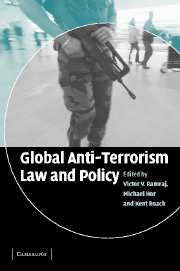Book contents
- Frontmatter
- Contents
- List of contributors
- Acknowledgements
- 1 Introduction
- PART ONE Theoretical Perspectives on Anti-Terrorism Law and Policy
- PART TWO A Comparative Study of Anti-Terrorism Measures
- PART THREE Anti-Terrorism Law and Policy in Asia
- PART FOUR Regional Cooperation
- PART FIVE Anti-Terrorism Law and Policy in the West
- 21 Legislative over-breadth, democratic failure and the judicial response: fundamental rights and the UK's anti-terrorist legal policy
- 22 United States responses to September 11
- 23 Canada's response to terrorism
- 24 The rule of law and the regulation of terrorism in Australia and New Zealand
- PART SIX Anti-Terrorism Measures in Africa, the Middle East and Argentina
- Index
23 - Canada's response to terrorism
Published online by Cambridge University Press: 21 July 2009
- Frontmatter
- Contents
- List of contributors
- Acknowledgements
- 1 Introduction
- PART ONE Theoretical Perspectives on Anti-Terrorism Law and Policy
- PART TWO A Comparative Study of Anti-Terrorism Measures
- PART THREE Anti-Terrorism Law and Policy in Asia
- PART FOUR Regional Cooperation
- PART FIVE Anti-Terrorism Law and Policy in the West
- 21 Legislative over-breadth, democratic failure and the judicial response: fundamental rights and the UK's anti-terrorist legal policy
- 22 United States responses to September 11
- 23 Canada's response to terrorism
- 24 The rule of law and the regulation of terrorism in Australia and New Zealand
- PART SIX Anti-Terrorism Measures in Africa, the Middle East and Argentina
- Index
Summary
Canada's response to terrorism has been dramatically affected by 9/11. Canadians died in the horrific attacks on the World Trade Center, but so did the citizens of many other countries. What was unique about Canada's response to 9/11 was the border it shares with the United States. The border meant that Canada felt the repercussions of the swift American response to the attacks in an immediate and profound manner. For example, when the United States closed its air space that terrible day, it was Canada that accepted over 200 airplanes destined for the United States, including one plane that was erroneously believed to have been hijacked. Canada also was affected by erroneous claims that some of the terrorists had entered the United States through Canada, as indeed had occurred before and may likely occur again given the millions who cross the border each day. Canada was also singled out in the USA Patriot Act which contained a whole section entitled ‘Defending the Northern Border’ providing for increased border guards and scrutiny of those entering the United States. Important components of Canada's anti-terrorism and immigration policies have been established in border agreements with the United States. Canada has drafted broad new anti-terrorism laws and developed a new public safety department of government with an eye to American perceptions that Canada might provide a safe haven for terrorists.
- Type
- Chapter
- Information
- Global Anti-Terrorism Law and Policy , pp. 511 - 533Publisher: Cambridge University PressPrint publication year: 2005
- 4
- Cited by



